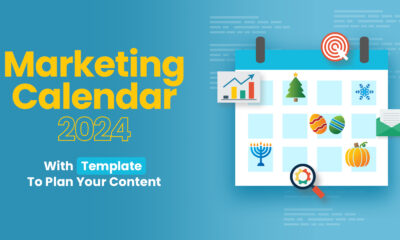MARKETING
Best Goal Setting Worksheet to Help You Plan & Achieve

Accomplishing your goals is an incredibly gratifying feeling.
However, it can sometimes be challenging to get that feeling, since achieving goals takes time, effort, and a structured process.
This is why it’s important to create plans of action for meeting the goals that will help you stay motivated and ensure you’re on the right path.
In this post, we’ll go over three goal-setting worksheets created by HubSpot to help you outline your goals with the SMART framework and create a plan for achieving them.
The template is broken down into relevant sections to help you through the process, and if you download it, you can follow along throughout the post.
Download your free marketing goal-setting template here.
Goal-Setting Template
When it comes to setting a goal, there’s power in writing it down. Research shows that writing aids in retention and recall — and helps to clarify our goals.
This is essential when planning your next week, month, quarter, or year. By keeping a clear goal in mind, you’ll be able to see how far you’ve progressed and stay on track.
However, even when we know what we want to achieve, it can be hard to know where to start. Enter HubSpot’s goal-setting template.
In this template, you’ll find a:
- Goal-setting worksheet
- Goal-calculation worksheet
- Goal-evaluation worksheet
Let’s walk through each step in the template — setting a SMART goal, calculating numerical targets to hit, and evaluating any roadblocks standing in your way.
Goal-Setting Steps
1. Identify your initial goal.
The first step of the process is to simply identify what your goal is. It doesn’t have to be convoluted, just merely the objective you’re hoping to achieve. For example, if you’re hoping to grow your website, your baseline goal could be “I want to generate more site traffic.”
2. Define your SMART goals.
The second step in the process is to use the SMART framework to elaborate your goals to ensure that they’re clear, measurable and that the process will help you get there. Here is what each of the element in the acronym stands for:
- Specific: A specific goal clearly outlines what you’re hoping to improve. If you share your specific goals with your team, it should be clear what your intention is.
- Measurable: Making your goal measurable means attaching numbers to your objective that will help you understand what you have to meet, track your progress, and see how long it will take you to reach your end goal.
- Attainable: Making sure that your goals are attainable means that they are realistic and that you have a chance of achieving them. Your goal is not too out of left field or so unrelated to your current practices that you wouldn’t be able to succeed.
- Relevant: Ensuring that your goal is relevant involves answering the question of “Why are you setting the goal that you’re setting?” Your goal should directly relate to your business’ needs and help your business grow.
- Time-Bound: The final aspect of your goal-setting process is to set a timeline. It helps you understand what your schedule should be and stay on track in terms of achieving your ultimate goal.
Using the goal-setting worksheet, fill out your initial goal and follow the steps to make it SMART.
Goal-Setting Worksheet Example
Let’s suppose your goal is to increase your blog’s website traffic. Following the steps in our goal-setting worksheet, here’s how you can turn this into a SMART goal:
- Specific: I want to increase my blog’s traffic.
- Measurable: I want to increase blog traffic by 5%.
- Attainable: I can hire a freelancer to increase my posting frequency by 1-3 posts per week.
- Relevant: Increasing blog traffic will contribute to my objective of boosting brand authority.
- Timebound: I want to reach this goal in six months.
Smart goal: To boost my blog’s website traffic by 5% in six months. I will do this by increasing the publishing frequency per week.
3. Calculate your goal outcomes.
The most challenging part of your plan might be coming up with numerical targets that coincide with achieving your goals. You can just say, “We want to increase blog traffic by 5%,” but what would the 5% increase look like in numerical form? Specify the number of views you need to have to reach this goal.
When you have these numbers, you can set milestones for yourself and monitor your progress and make changes along the way if necessary.
Goal-Calculation Worksheet Example
Let’s say your average 1,000 blog views per month. Since you want to increase your traffic by 5% in six months, you need to know your monthly traffic target.
Using the goal-calculation worksheet, you input the following information:

From the calculations, you can see 1,340 is your recommended monthly traffic target.
4. Evaluate your SMART goals.
The template’s final step is to evaluate your goals, which helps you anticipate possible roadblocks and develop action plans for dealing with them. If you have multiple goals, aim to ask these questions for each one that you have:
- What is your SMART marketing goal?
- Do you feel that this goal is realistically attainable in the time frame you’ve set?
- How many hours per week can you dedicate to achieving your goal/your goal process?
- What is the biggest challenge preventing you from achieving this goal? What are possible challenges you may face in achieving this goal? What is the biggest roadblock(s) to achieving this goal?
- What three steps can you take to reduce or remove that challenge and succeed in reaching this goal?
Goal-Evaluation Worksheet Example
Using the goal-evaluation worksheet, you evaluate your SMART goal. You discover two challenges that could hinder your success — hiring freelancers and organizing a new editorial content calendar.

With this in mind, you can begin to brainstorm ways to minimize or eliminate these obstacles. For example, you could create a new content calendar using tools like Monday.com or Trello.
All in all, following this framework makes your goals explicitly clear for yourself and helps you communicate their importance to all necessary stakeholders, so everyone is on the same page. To get started, download our template for free and start achieving your goals.
Source link





















You must be logged in to post a comment Login